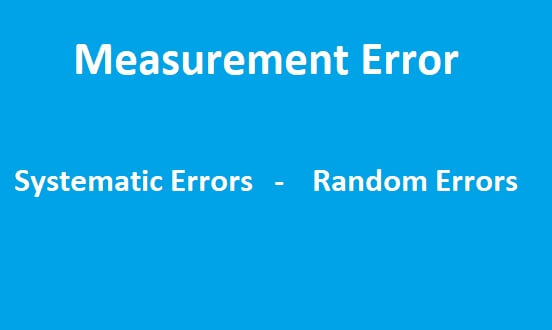Systematic and Random Errors in Measurement
Systematic error is usually divided into two different categories:
- Instrumental errors
- Environmental errors
Instrumental error : These errors are due to shortcomings of the instrument. These are errors inherent in measuring instruments because of their mechanical structure. For example, in the D’Arsonval movement friction in bearings of various moving components may cause incorrect readings. Irregular spring tension, stretching of spring or reduction in tension due to improper handling or overloading of the instrument will result in errors. Other instrumental errors are calibration errors, causing the instrument to read high or low along its entire scale.
These are many kinds of instrumental errors depending on the type of instrument used. Faults in instruments may be detected by checking for erratic behavior, stability and reproduceability of results.
Environmental error : These errors are due to conditions external to the measuring device such as effects of changes in temperature, humidity, barometric pressure, or of magnetic or electrostatic fields. For example, a change in ambient temperature at which the instrument is used to cause a change in elastic properties of the material of Vernier caliper and so affects the reading of the instrument. Corrective measures to reduce these effects should be taken accordingly.
Random error
These errors are due to unknown causes and occur even when all systematic errors have been accounted. Random errors are generally an accumulation of a large number of small effects and may be of real concern only in measurements requiring a high degree of accuracy.
These errors are due to unknown causes, not determinable in the ordinary process of making measurements. Such errors are normally small and follow the laws of probability. Random errors can thus be treated mathematically.
The sources for this type of errors are
1. Displacement of level joints in the measuring instrument.
2. Small variation in the position of settings.
3. Reading scale error due to operator.
Comparison between Systematic Error and Random Errors
| Systematic Errors | Random Errors |
| It can be controlled by magnitude and sense. | It cannot be determined from the knowledge of measuring system. |
| It is repetitive in nature. | It is non consistent |
| Property analyzed can be determined and reduced. | Cannot be eliminated. |
| These types of errors are due to improper conditions or procedures. | Random errors are inherent in the measuring system. |
| These include the variation in atmospheric conditions, misalignment errors. | It includes errors due to displacement of level joints, errors due to friction. |
Correction
Correction is defined as a value which is added algebraically to the uncorrected result of measurement to compensate for an assumed systematic error.
If a numerical value is multiplied with uncorrected results to compensate for an assumed systematic error, it is known as correction factor.






